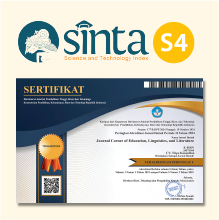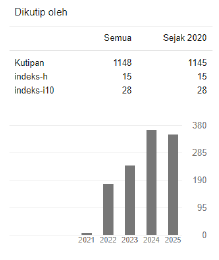Language Acquisition of Declarative and Imperative Sentences in five-year-old Children
 https://doi.org/10.54012/jcell.v3i3.275
https://doi.org/10.54012/jcell.v3i3.275
 Abstract views: 549
Abstract views: 549
 PDF downloads: 508
PDF downloads: 508
Keywords:
language acquisition, children's language, five-year-old Children, Imperative, declarativeAbstract
This study aims to describe the language acquisition of a five-year-old child. This research focuses on declarative and imperative sentence forms, using a descriptive qualitative approach with recording techniques. The analysis results show that the syntactic acquisition in declarative sentences has four forms, and imperative has five. The category of language acquisition at the syntactic level is good enough because there is minimal deviation from the form of speech produced. In summary, five-year-old children will likely use declarative and imperative sentences as they develop their language skills. They may start to use declarative sentences more naturally to convey information and use imperative sentences to express commands or requests, although their usage of these sentence types may vary in complexity and grammatical accuracy. Shortly, the results showed that children's utterances dominate in imperative sentences.
Downloads
References
Anidar, Jum. (2017). Teori Belajar Menurut Aliran Kognitif Serta Implikasinya dalam Pembelajaran. Jurnal Al-Taujih: Bingkai Bimbingan dan Konseling Islami. Universitas Imam Bonjol Padang. Volume 3, Nomor 2, pp 8-16.
Bellugi, U. (1964). Three Processes in the Child’s Acquisition of Syntax. Harvard Educational Review 34.
Bloom, L. (1970). Language Development: Form and Function in Emerging Grammars. Cambridge, Mass: MIT Press.
Brown. (1973). A First Language. The Early Stages. Cambridge. MA: Harvard University Press.
Chaerm Abdul. (2018). Sintaksis Bahasa Indonesia. Jakarta: PT Rineka Cipta.
Chomsky, N. Interview. (1977). Dalam Cohen, D., Psychologists on Psychology. New York: Taplinger.
Delpiyani., Purnamasari, Rika., & Hasanah, Iis Uswatun. (2023). First Language Acquisition In Early Children 3-4 Years. (Descriptive Qualitative Study in Parakanlima Village). International Journal of Early Childhood in Community Learning. Volume 1, Nomor 1, pp 23-29.
Fromkin, Victoria dan Robert Rodman. (1993). An Introduction to Language. Florida: Harcourt Brace Jovanovich Collage.
Kholifah, Umi. (2019). Pemerolehan Kalimat Ujaran Bahasa Indonesia dengan Lima Kata Anak Usia 4—5 Tahun. Seminar Nasional Literasi Prodi PBSI FPBS UPGRIS. Volume 4, Nomor 1, pp 391-400.
Khotimah, Khusnul. (2021). Pengaruh Bahasa Baku Terhadap Pemerolehan Bahasa Anak Usia 7-8 Tahun. Lingua Franca: Jurnal Bahasa, Sastra, dan Pengajarannya. Volume 5, Nomor 1, pp 206-218.
Mahsun. (2014). Teks dalam Pembelajaran Bahasa Indonesia Kurikulum 2013. Jakarta: PT Raja Grafindo Persada.
Moleong, Lexy J. (2019). Metodologi Penelitian Kualitatif. Bandung : PT. Remaja Rosdakarya.
Mulyadi, Yonathan Yoel.,& Liauw, Franky. (2020). Wadah Interaksi Sosial. Jurnal STUPA: Sains, Teknologi, Urban, Perancangan, Arsitekstur. Volume 2, Nomor 1, pp 37-43.
Natsir, Nurasia. (2017). Hubungan Psikolinguistik dalam Pemerolehan dan Pembelajaran Bahasa. Jurnal Retorika. Volume 10, Nomor 1, pp 20-29.
Nissa, Kanaya Afflaha., Zahrah, Nuria Alfi., & Putra, Dona Aji Karunia. (2022). Pemerolehan Bahasa Anak Usia 3-4 Tahun (Studi Kasus Pada Siswa Paud Pitara Pondok Cabe Ilir, Tangerang Selatan). Medan Makna: Jurnal Ilmu Kebahasaan dan Kesastraan. Volume 20, Nomor 1.
Sentosa, Aji Rahmat., & Apriliani, Nia. (2020). Pemerolehan Bahasa Pada Anak Usia Dini (Kajian Psikolinguistik). Seminar Nasional Pendidikan, Fakultas Keguruan dan Ilmu Pendiidkan Universitas Majalengka. Volume 2, pp 1-7.
Suardi, Indah Permatasari., Ramadhan, Syahrul., Asri, Yasnur. (2019). Pemerolehan Bahasa Pertama pada Anak Usia Dini. Jurnal Obsesi: Jurnal Pendidikan Anak Usia Dini. Volume 3, Nomor 1, pp 265-273.
Sulistyowati, Heny. (2022). Pemerolehan Bahasa Pada Siswa Autis Di Sekolah Luar Biasa Mutiara Kasih Plemahan Kediri. Prosiding Seminar Nasional “Penelitian Bahasa Daerah: Ruang Lingkup dan Metode”. APBL: Asosiasi Peneliti Bahasa Lokal Daerah Sulawesi Utara. Pp 27-33.
Suparman. (2022). Pemerolehan Bahasa Anak Usia 3 Tahun. Bahtera Indonesia: Jurnal Penelitian Bahasa dan Sastra Indonesia. Volume 7, Nomor 1, pp 67-77.
Tarigan, H. G. (2015). Berbicara Sebagai Suatu Keterampilan Berbahasa. Bandung: Angkasa.
Usman, Hakim. (2015). Studi Pemerolehan Bahasa Pada Anak Usia 4 Tahun (Kajian Sintaksis). JLT-Jurnal Linguistik Terapan Politeknik Negeri Malang. Volume 5, Nomor 2, pp 16-27.
Aldosari, H. S. (2019). An Interacultural Perspective on Teaching and Learning Efl at the University Level. The 2nd International Conference on Language, Literature, and Teaching.
Alshenqeeti, H. (2014). Interviewing as a Data Collection Method: A Critical Review. English Linguistics Research, 3(1), 39–45. https://doi.org/10.5430/elr.v3n1p39
Anum, A., Susanti, R., & Syakur, A. (2024). Indonesian Language Acquisition of 0-2-Year-Old Children : A Study of Psycholinguistic Perspective. Journal Corner of Education, Linguistics, and Literature, 3(3), 296–308.
Azucar, D., Marengo, D., & Settanni, M. (2018). Predicting the Big 5 personality traits from digital footprints on social media: A meta-analysis. Personality and Individual Differences, 124(September 2017), 150–159. https://doi.org/10.1016/j.paid.2017.12.018
Barreda, S. (2016). Investigating the use of formant frequencies in listener judgments of speaker size. Journal of Phonetics, 55, 1–18. https://doi.org/10.1016/j.wocn.2015.11.004
Evans, H. (2000). EDUCATION FOR ALL IN THE CARIBBEAN : ASSESSMENT 2000 Series Editor : Lynda Quamina-Aiyejina GENDER DIFFERENCES IN EDUCATION IN JAMAICA. In Assessment.
Gudjonsson, G. H. (2003). The Psychology of Interrogations and Confession (R. Davies, Graham & Bull (ed.); The Psycho). Wiley.
Herman, M., Mulya, C., & Apriyanto, S. (2021). The Implementation of Education Financing Through Bos Fund Management in Improving. Jurnal Inspiratif Pendidikan, X(1), 90–101.
Hossain, M. M., & Fatema, K. (2022). Diglossia as a Symbolic Capital in Bangladesh: A Bourdieun Analysis. Journal Corner of Education, Linguistics, and Literature, 2(2), 81–94. https://doi.org/10.54012/jcell.v2i2.71
Kerry Linfoot. (2007). FORENSIC LINGUISTICS, FIRST CONTACT POLICE INTERVIEWS, AND BASIC OFFICER TRAINING. UNIVERSITY OF FLORIDA.
Levinson, S. C. (1983). Pragmatics (1st ed.). Cambridge University Press.
Nida, E. A., & Wonderly, W. L. (1971). Communication Roles of Languages in Multilingual Societies. The Bible Translator, 22(1), 19–37. https://doi.org/10.1177/000608447102200103
Niklas, F., Cohrssen, C., & Tayler, C. (2016). Home Learning Environment and Concept Formation: A Family Intervention Study with Kindergarten Children. Early Childhood Education Journal, 44(5), 419–427. https://doi.org/10.1007/s10643-015-0726-1
Rentfrow, P. J., & Gosling, S. D. (2003). The Do Re Mi’s of Everyday Life: The Structure and Personality Correlates of Music Preferences. Journal of Personality and Social Psychology, 84(6), 1236–1256. https://doi.org/10.1037/0022-3514.84.6.1236
Saragih, D., Simangunsong, T. I. S., Simanjuntak, D. N., Saragih, R. R. N., & Siagian, K. (2023). Analysis of Types of English Sentences in English Folklore “Jack and the Beanstalk” from American Literature Website. International Journal Corner of Educational Research, 2(2), 57–63. https://doi.org/10.54012/ijcer.v2i2.205
Sliedrecht, K. Y., Van der Houwen, F., & Schasfoort, M. (2016). Challenging formulations in police interrogations and job interviews: A comparative study. Journal of Pragmatics, 105, 114–129. https://doi.org/10.1016/j.pragma.2015.09.002
Slonje, R., & Smith, P. K. (2008). Cyberbullying: Another main type of bullying?: Personality and Social Sciences. Scandinavian Journal of Psychology, 49(2), 147–154. https://doi.org/10.1111/j.1467-9450.2007.00611.x
Soni, R. R., Manik, L., Sinaga, R., & Samosir, D. (2023). Contrastive Analysis of Indonesian and English Declarative Sentences in News Article “6 Fakta Baru Kecelakaan Maut Cibubur Hingga Sopir-Kernet Truk Tersangka” on Detiknews Website. International Journal Corner of Educational Research, 2(1), 23–30. https://doi.org/10.54012/ijcer.v2i1.189
Tak, P. J. P. (1999). The Dutch Criminal Justice System. In Organization and operation (p. 40). Wetenschappelijk Onderzoek- en Documentatiecentrum.
Teh, J. L., & Pilus, Z. (2019). International students’ perspectives of Malaysian English teachers’ spoken English. Indonesian Journal of Applied Linguistics, 8(3), 555–566. https://doi.org/10.17509/ijal.v8i3.15255
Toth, K., Sammons, P., Sylva, K., Melhuish, E., Siraj, I., & Taggart, B. (2020). Home learning environment across time: the role of early years HLE and background in predicting HLE at later ages. School Effectiveness and School Improvement, 31(1), 7–30. https://doi.org/10.1080/09243453.2019.1618348
Tõugu, P., & Tulviste, T. (2017). Links between children’s language comprehension and expressive vocabulary and their personality traits: A longitudinal investigation. Learning and Individual Differences, 57, 123–128. https://doi.org/10.1016/j.lindif.2017.03.015
Downloads
Published
How to Cite
Issue
Section
License
Copyright (c) 2024 Wahyu Budi, Nur Halimah, Heri Indarto

This work is licensed under a Creative Commons Attribution-ShareAlike 4.0 International License.
All articles published in the Journal Corner of Education, Linguistics, and Literature are licensed under the Creative Commons Attribution-ShareAlike License (CC BY-SA).

















